HNCB 20 Principles of Structural Design: Beam Design and Analysis
VerifiedAdded on 2022/12/14
|31
|3756
|208
Homework Assignment
AI Summary
This assignment solution covers key principles of structural design, focusing on bending moments, shear forces, and beam analysis. It begins with calculating reactions, shear forces, and bending moments for various beam arrangements, including simply supported beams and those with distributed loads. The solution also addresses statutory requirements in structural design, such as safety, fire safety, resistance to contaminants, toxic substances, sound, ventilation, sanitation, drainage, heat-producing appliances, protection from falling, conservation of fuel, and access to buildings. It further explores factors of safety for dead, imposed, and live loads, and details the process of steel beam selection based on bending moment calculations. The document also discusses how deflection in beams affects structural stability and examines various methods of support for structures, including roller, pinned, fixed, hanger, and simple supports, and their effects on deflection. Finally, the assignment analyzes materials for their capacity and resistance to corrosion and weathering.
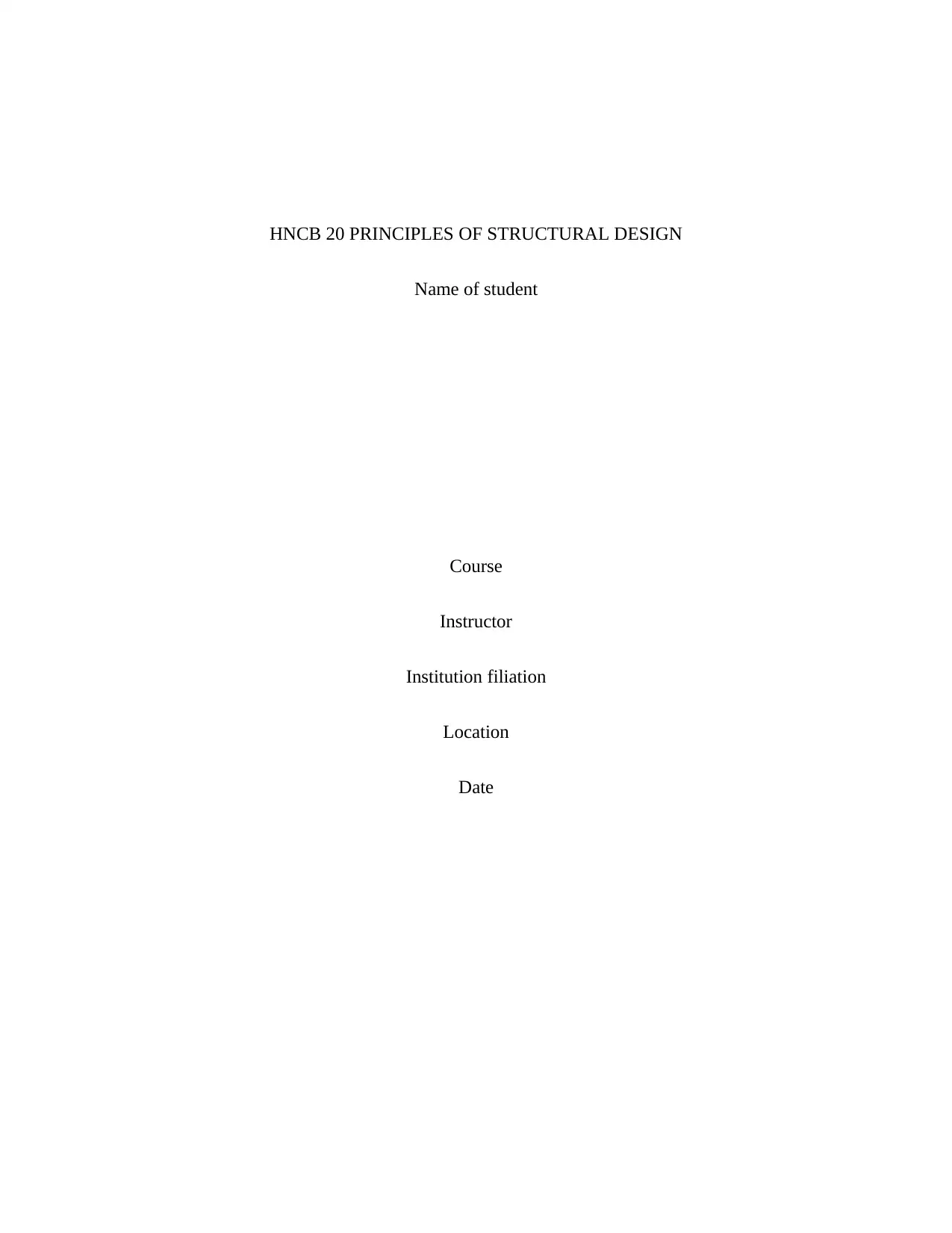
HNCB 20 PRINCIPLES OF STRUCTURAL DESIGN
Name of student
Course
Instructor
Institution filiation
Location
Date
Name of student
Course
Instructor
Institution filiation
Location
Date
Paraphrase This Document
Need a fresh take? Get an instant paraphrase of this document with our AI Paraphraser
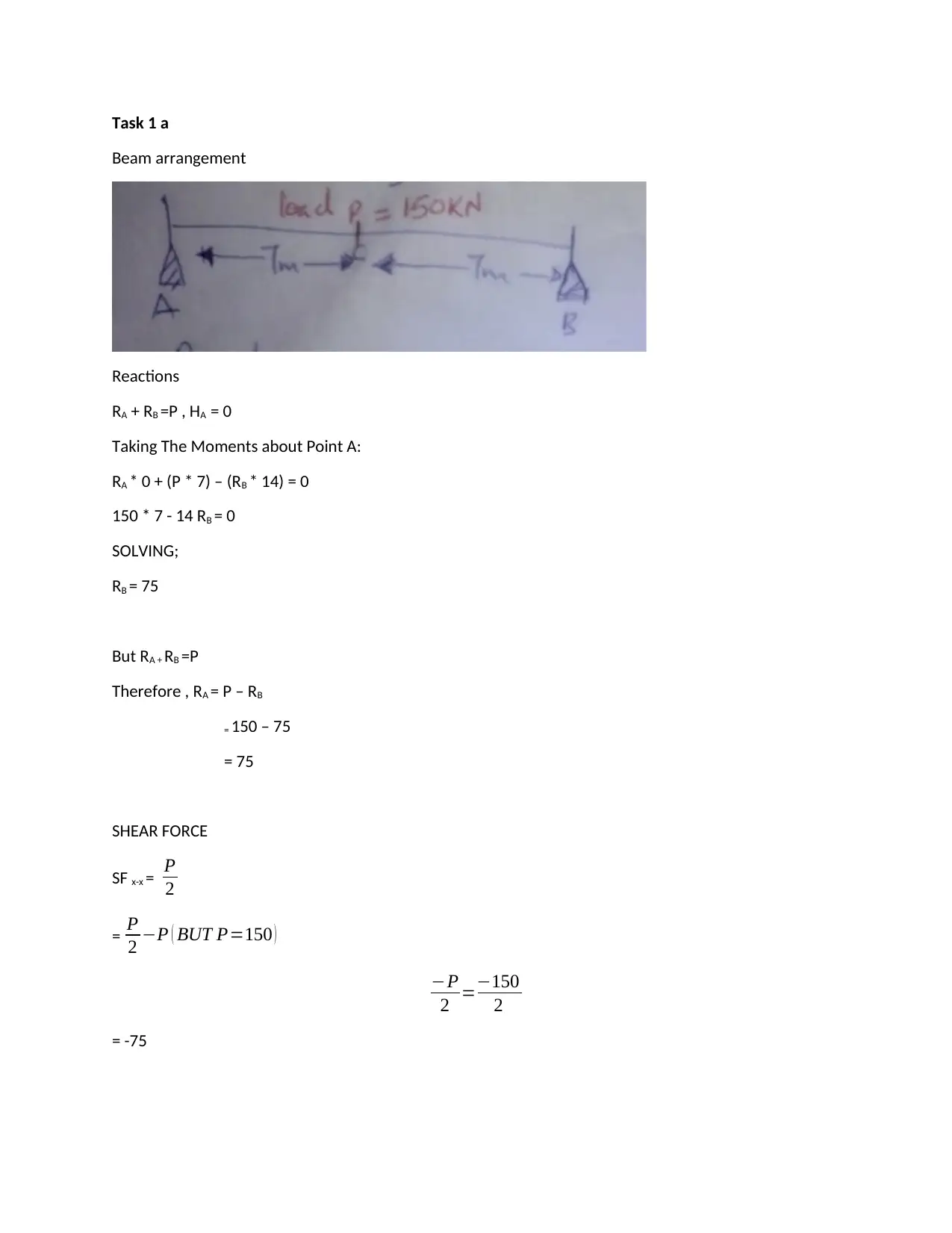
Task 1 a
Beam arrangement
Reactions
RA + RB =P , HA = 0
Taking The Moments about Point A:
RA * 0 + (P * 7) – (RB * 14) = 0
150 * 7 - 14 RB = 0
SOLVING;
RB = 75
But RA + RB =P
Therefore , RA = P – RB
= 150 – 75
= 75
SHEAR FORCE
SF x-x = P
2
= P
2 −P ( BUT P=150 )
−P
2 =−150
2
= -75
Beam arrangement
Reactions
RA + RB =P , HA = 0
Taking The Moments about Point A:
RA * 0 + (P * 7) – (RB * 14) = 0
150 * 7 - 14 RB = 0
SOLVING;
RB = 75
But RA + RB =P
Therefore , RA = P – RB
= 150 – 75
= 75
SHEAR FORCE
SF x-x = P
2
= P
2 −P ( BUT P=150 )
−P
2 =−150
2
= -75
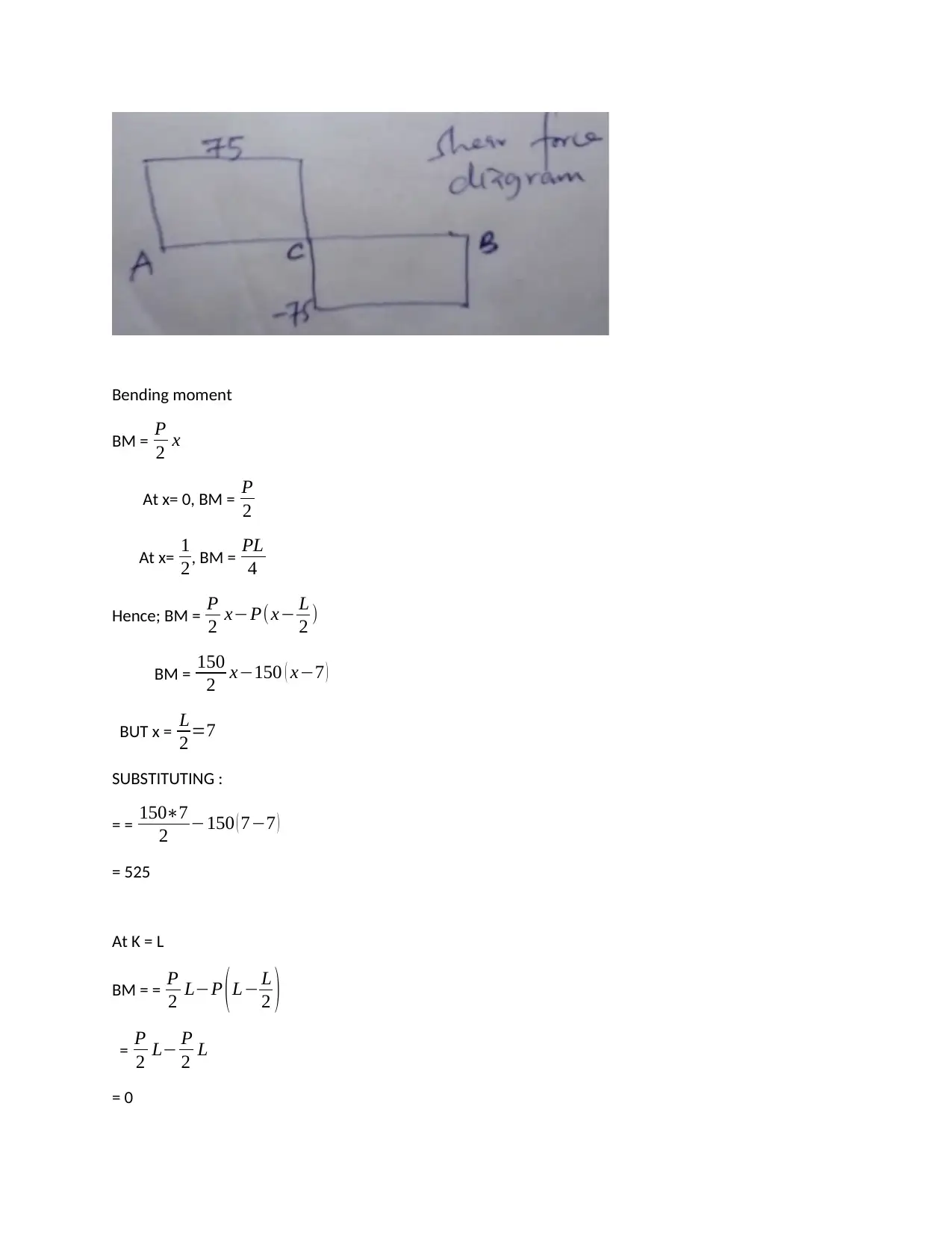
Bending moment
BM = P
2 x
At x= 0, BM = P
2
At x= 1
2, BM = PL
4
Hence; BM = P
2 x−P(x− L
2 )
BM = 150
2 x−150 ( x−7 )
BUT x = L
2 =7
SUBSTITUTING :
= = 150∗7
2 −150 ( 7−7 )
= 525
At K = L
BM = = P
2 L−P ( L− L
2 )
= P
2 L− P
2 L
= 0
BM = P
2 x
At x= 0, BM = P
2
At x= 1
2, BM = PL
4
Hence; BM = P
2 x−P(x− L
2 )
BM = 150
2 x−150 ( x−7 )
BUT x = L
2 =7
SUBSTITUTING :
= = 150∗7
2 −150 ( 7−7 )
= 525
At K = L
BM = = P
2 L−P ( L− L
2 )
= P
2 L− P
2 L
= 0
⊘ This is a preview!⊘
Do you want full access?
Subscribe today to unlock all pages.

Trusted by 1+ million students worldwide
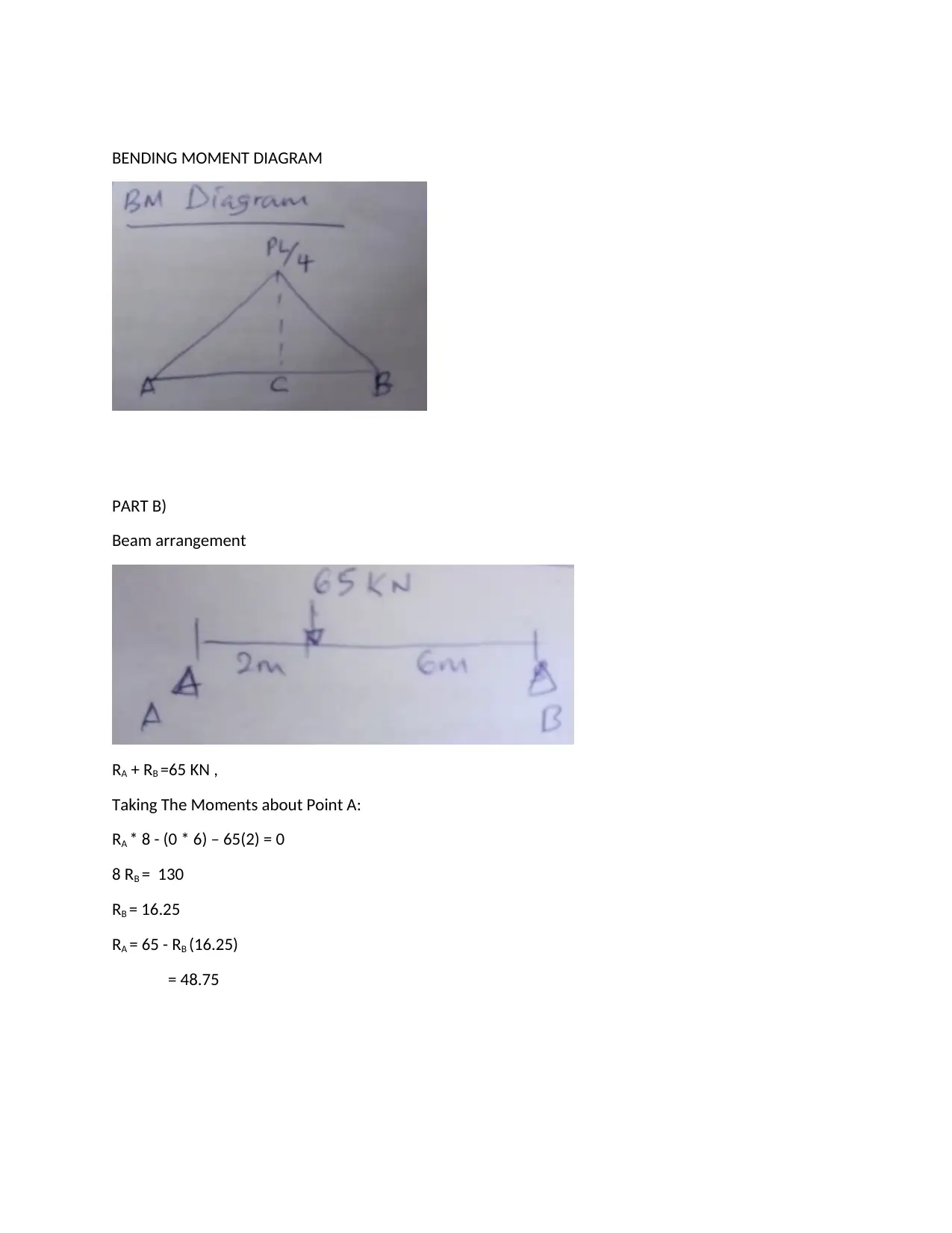
BENDING MOMENT DIAGRAM
PART B)
Beam arrangement
RA + RB =65 KN ,
Taking The Moments about Point A:
RA * 8 - (0 * 6) – 65(2) = 0
8 RB = 130
RB = 16.25
RA = 65 - RB (16.25)
= 48.75
PART B)
Beam arrangement
RA + RB =65 KN ,
Taking The Moments about Point A:
RA * 8 - (0 * 6) – 65(2) = 0
8 RB = 130
RB = 16.25
RA = 65 - RB (16.25)
= 48.75
Paraphrase This Document
Need a fresh take? Get an instant paraphrase of this document with our AI Paraphraser
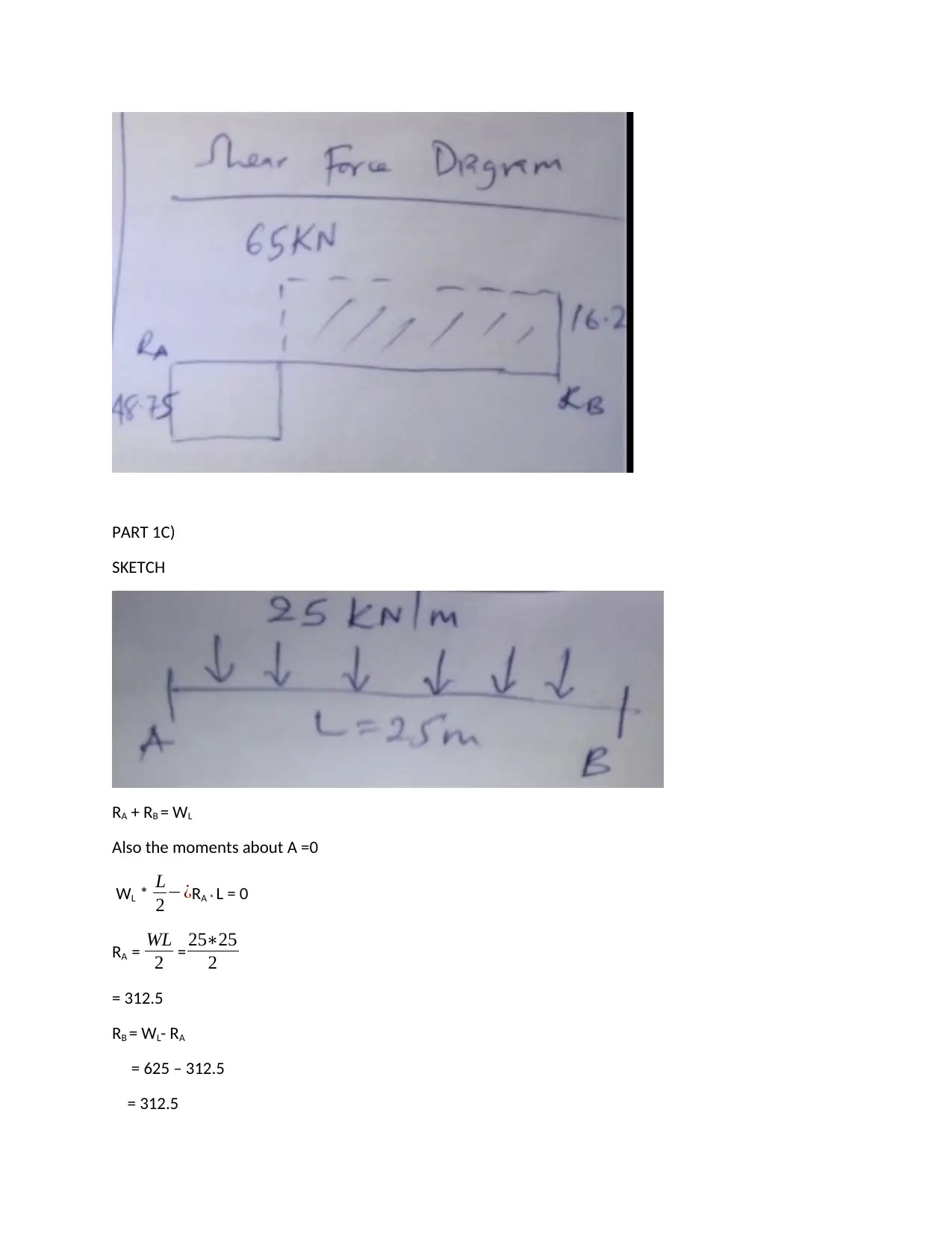
PART 1C)
SKETCH
RA + RB = WL
Also the moments about A =0
WL * L
2 −¿RA * L = 0
RA = WL
2 = 25∗25
2
= 312.5
RB = WL- RA
= 625 – 312.5
= 312.5
SKETCH
RA + RB = WL
Also the moments about A =0
WL * L
2 −¿RA * L = 0
RA = WL
2 = 25∗25
2
= 312.5
RB = WL- RA
= 625 – 312.5
= 312.5
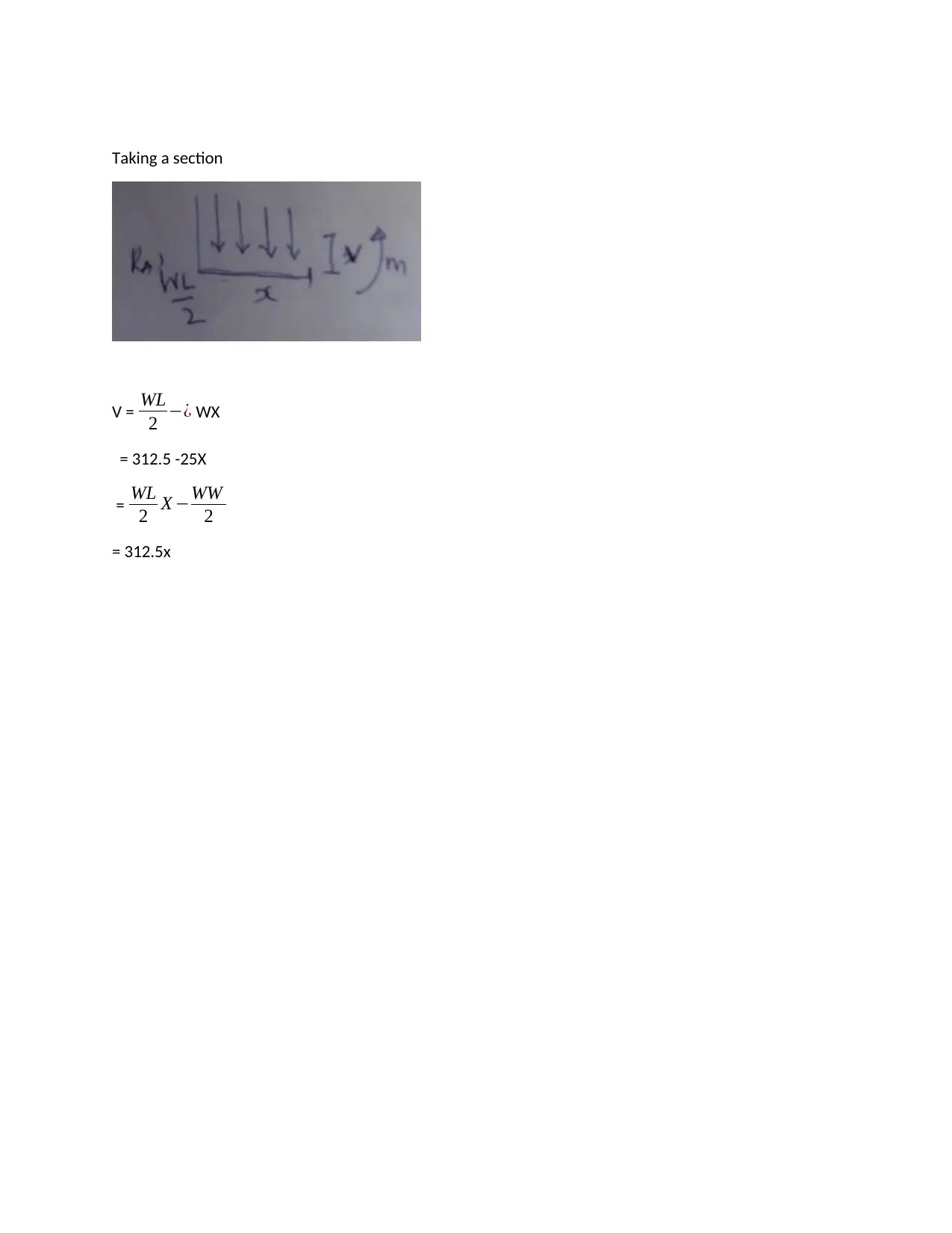
Taking a section
V = WL
2 −¿ WX
= 312.5 -25X
= WL
2 X −WW
2
= 312.5x
V = WL
2 −¿ WX
= 312.5 -25X
= WL
2 X −WW
2
= 312.5x
⊘ This is a preview!⊘
Do you want full access?
Subscribe today to unlock all pages.

Trusted by 1+ million students worldwide
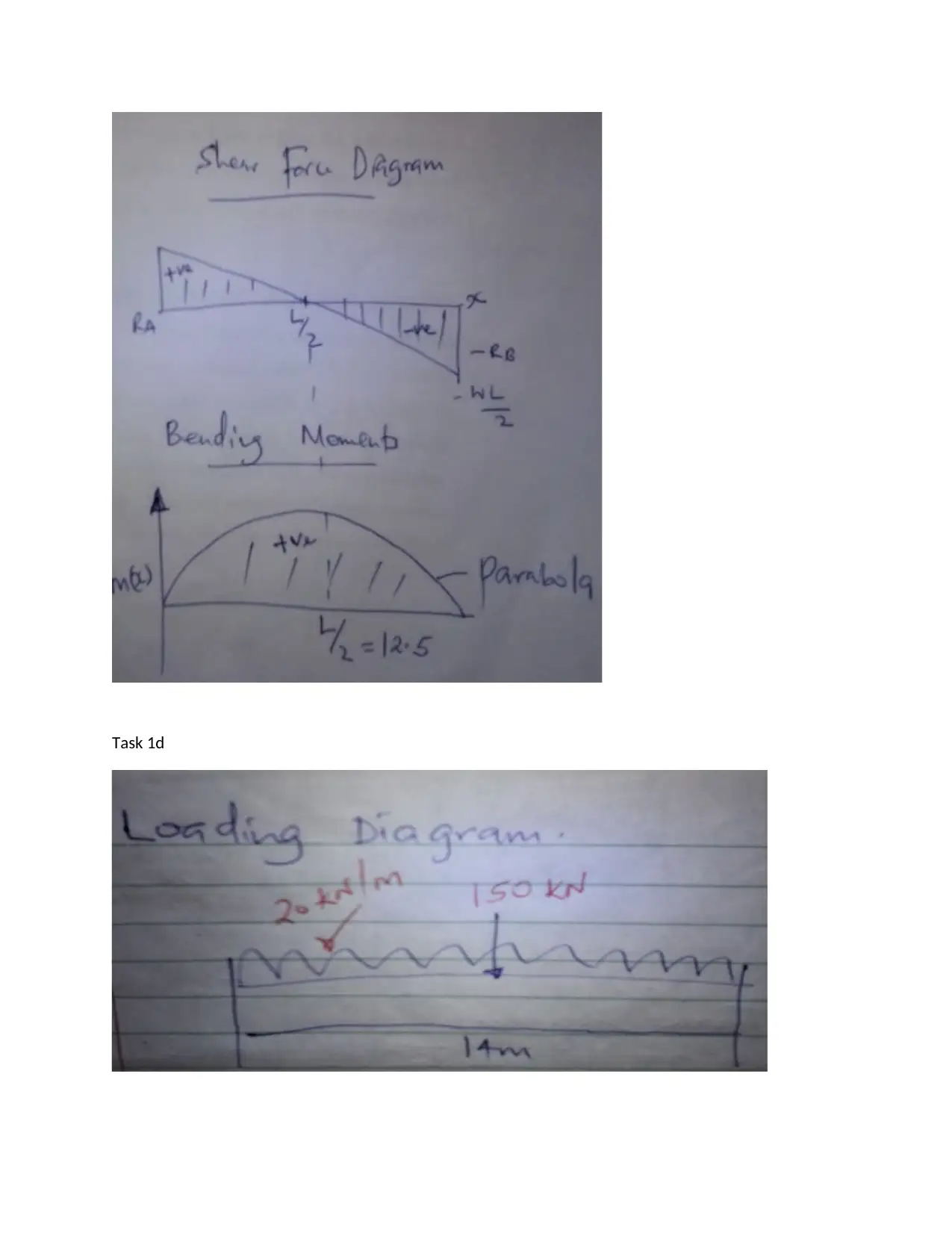
Task 1d
Paraphrase This Document
Need a fresh take? Get an instant paraphrase of this document with our AI Paraphraser
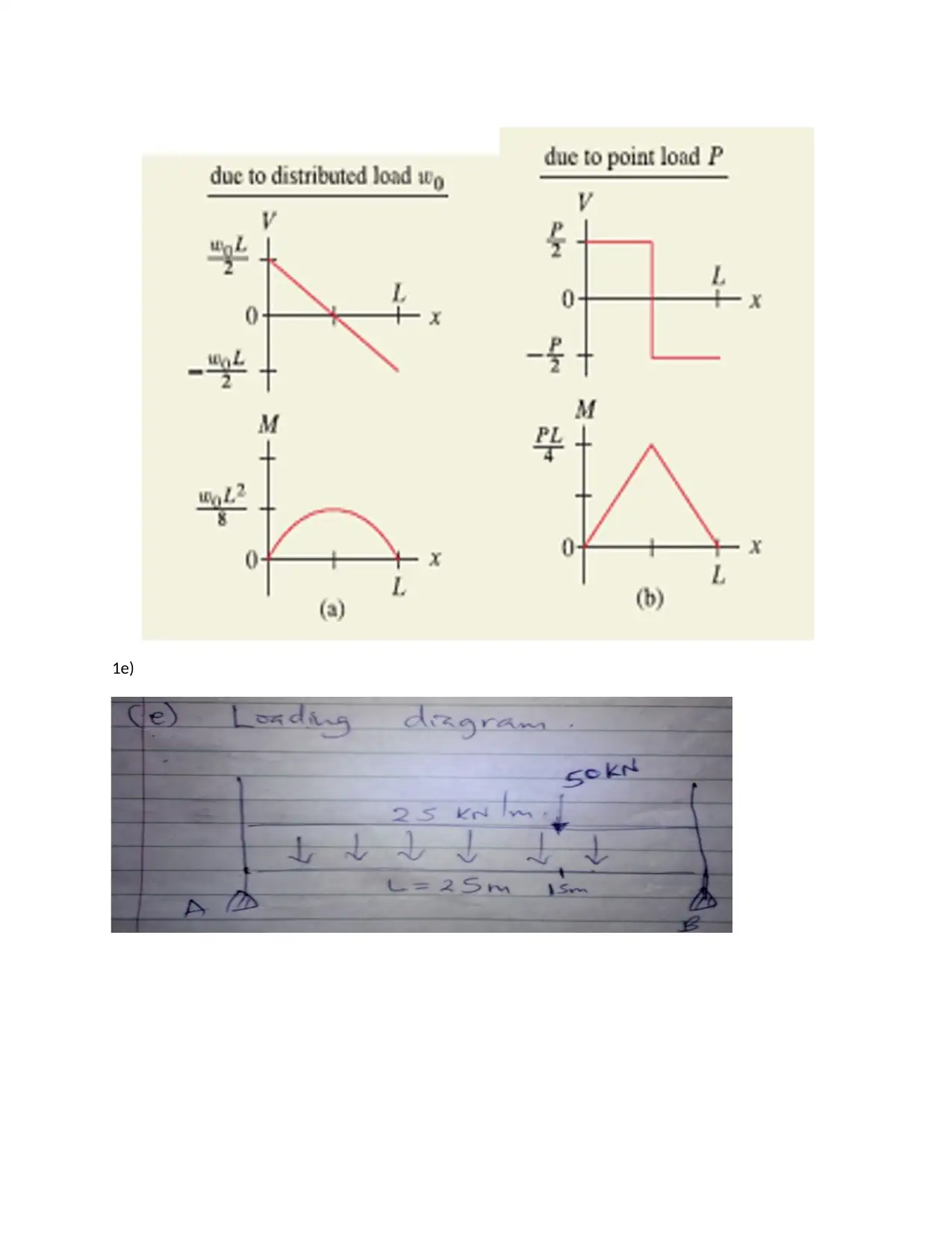
1e)
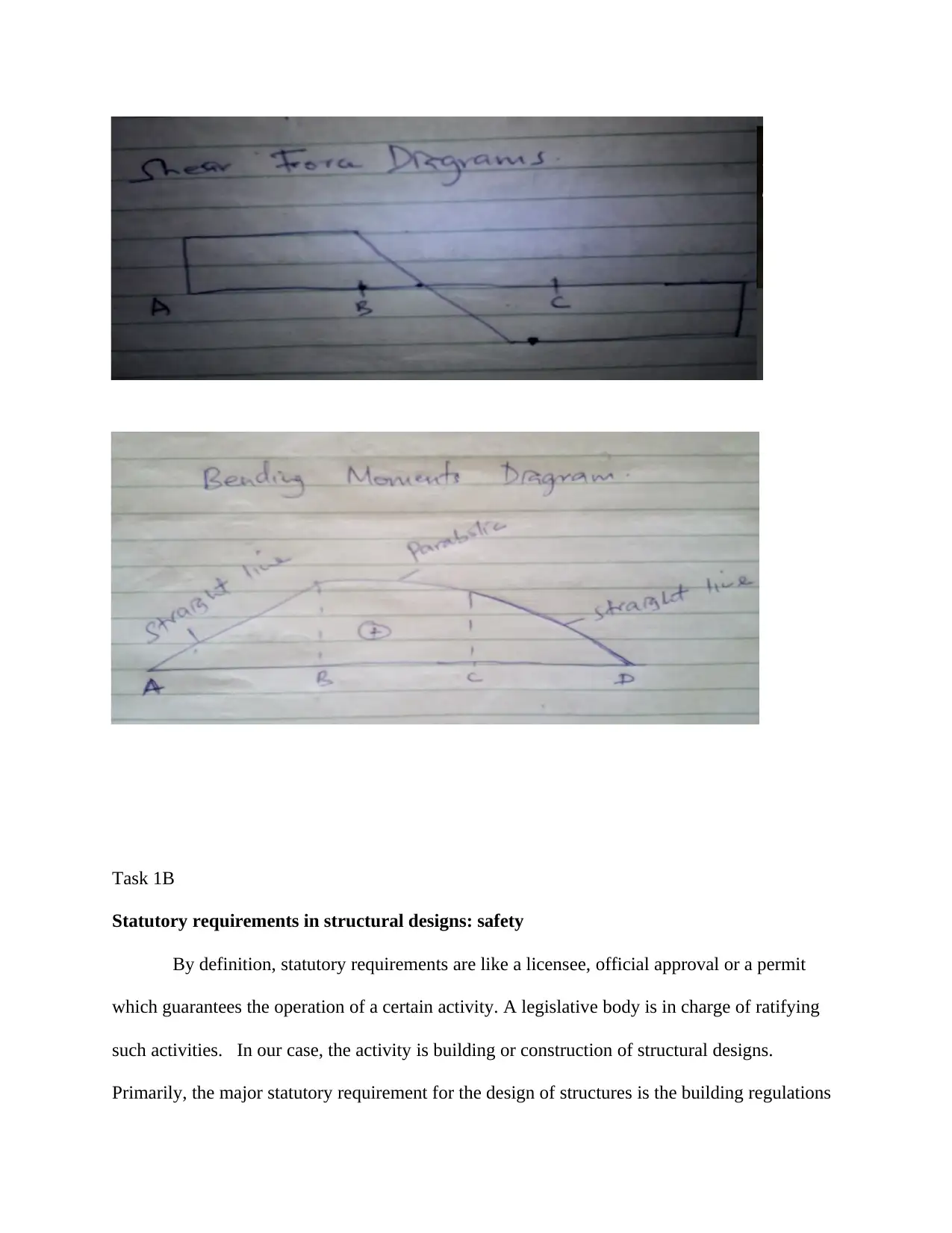
Task 1B
Statutory requirements in structural designs: safety
By definition, statutory requirements are like a licensee, official approval or a permit
which guarantees the operation of a certain activity. A legislative body is in charge of ratifying
such activities. In our case, the activity is building or construction of structural designs.
Primarily, the major statutory requirement for the design of structures is the building regulations
Statutory requirements in structural designs: safety
By definition, statutory requirements are like a licensee, official approval or a permit
which guarantees the operation of a certain activity. A legislative body is in charge of ratifying
such activities. In our case, the activity is building or construction of structural designs.
Primarily, the major statutory requirement for the design of structures is the building regulations
⊘ This is a preview!⊘
Do you want full access?
Subscribe today to unlock all pages.

Trusted by 1+ million students worldwide
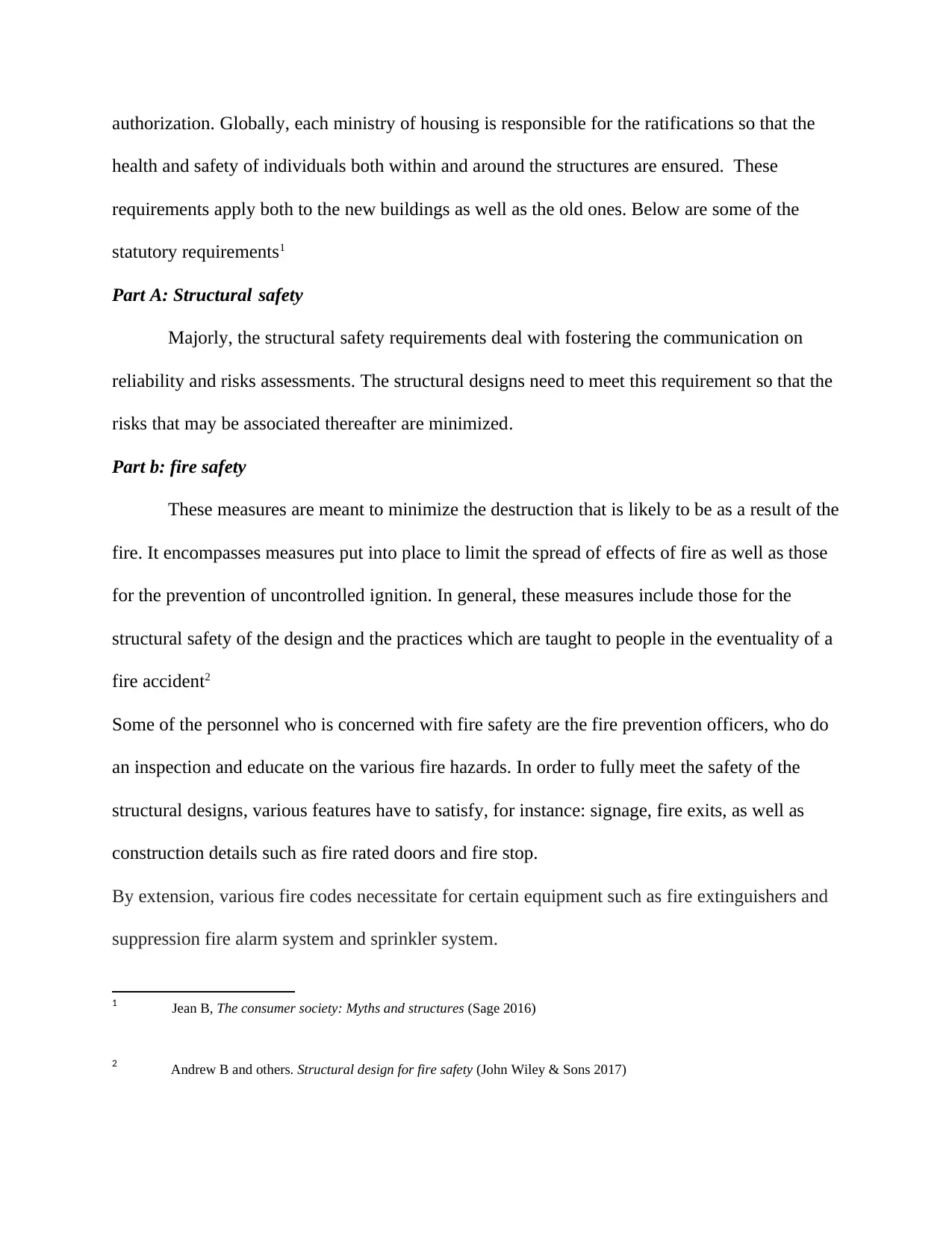
authorization. Globally, each ministry of housing is responsible for the ratifications so that the
health and safety of individuals both within and around the structures are ensured. These
requirements apply both to the new buildings as well as the old ones. Below are some of the
statutory requirements1
Part A: Structural safety
Majorly, the structural safety requirements deal with fostering the communication on
reliability and risks assessments. The structural designs need to meet this requirement so that the
risks that may be associated thereafter are minimized.
Part b: fire safety
These measures are meant to minimize the destruction that is likely to be as a result of the
fire. It encompasses measures put into place to limit the spread of effects of fire as well as those
for the prevention of uncontrolled ignition. In general, these measures include those for the
structural safety of the design and the practices which are taught to people in the eventuality of a
fire accident2
Some of the personnel who is concerned with fire safety are the fire prevention officers, who do
an inspection and educate on the various fire hazards. In order to fully meet the safety of the
structural designs, various features have to satisfy, for instance: signage, fire exits, as well as
construction details such as fire rated doors and fire stop.
By extension, various fire codes necessitate for certain equipment such as fire extinguishers and
suppression fire alarm system and sprinkler system.
1 Jean B, The consumer society: Myths and structures (Sage 2016)
2 Andrew B and others. Structural design for fire safety (John Wiley & Sons 2017)
health and safety of individuals both within and around the structures are ensured. These
requirements apply both to the new buildings as well as the old ones. Below are some of the
statutory requirements1
Part A: Structural safety
Majorly, the structural safety requirements deal with fostering the communication on
reliability and risks assessments. The structural designs need to meet this requirement so that the
risks that may be associated thereafter are minimized.
Part b: fire safety
These measures are meant to minimize the destruction that is likely to be as a result of the
fire. It encompasses measures put into place to limit the spread of effects of fire as well as those
for the prevention of uncontrolled ignition. In general, these measures include those for the
structural safety of the design and the practices which are taught to people in the eventuality of a
fire accident2
Some of the personnel who is concerned with fire safety are the fire prevention officers, who do
an inspection and educate on the various fire hazards. In order to fully meet the safety of the
structural designs, various features have to satisfy, for instance: signage, fire exits, as well as
construction details such as fire rated doors and fire stop.
By extension, various fire codes necessitate for certain equipment such as fire extinguishers and
suppression fire alarm system and sprinkler system.
1 Jean B, The consumer society: Myths and structures (Sage 2016)
2 Andrew B and others. Structural design for fire safety (John Wiley & Sons 2017)
Paraphrase This Document
Need a fresh take? Get an instant paraphrase of this document with our AI Paraphraser
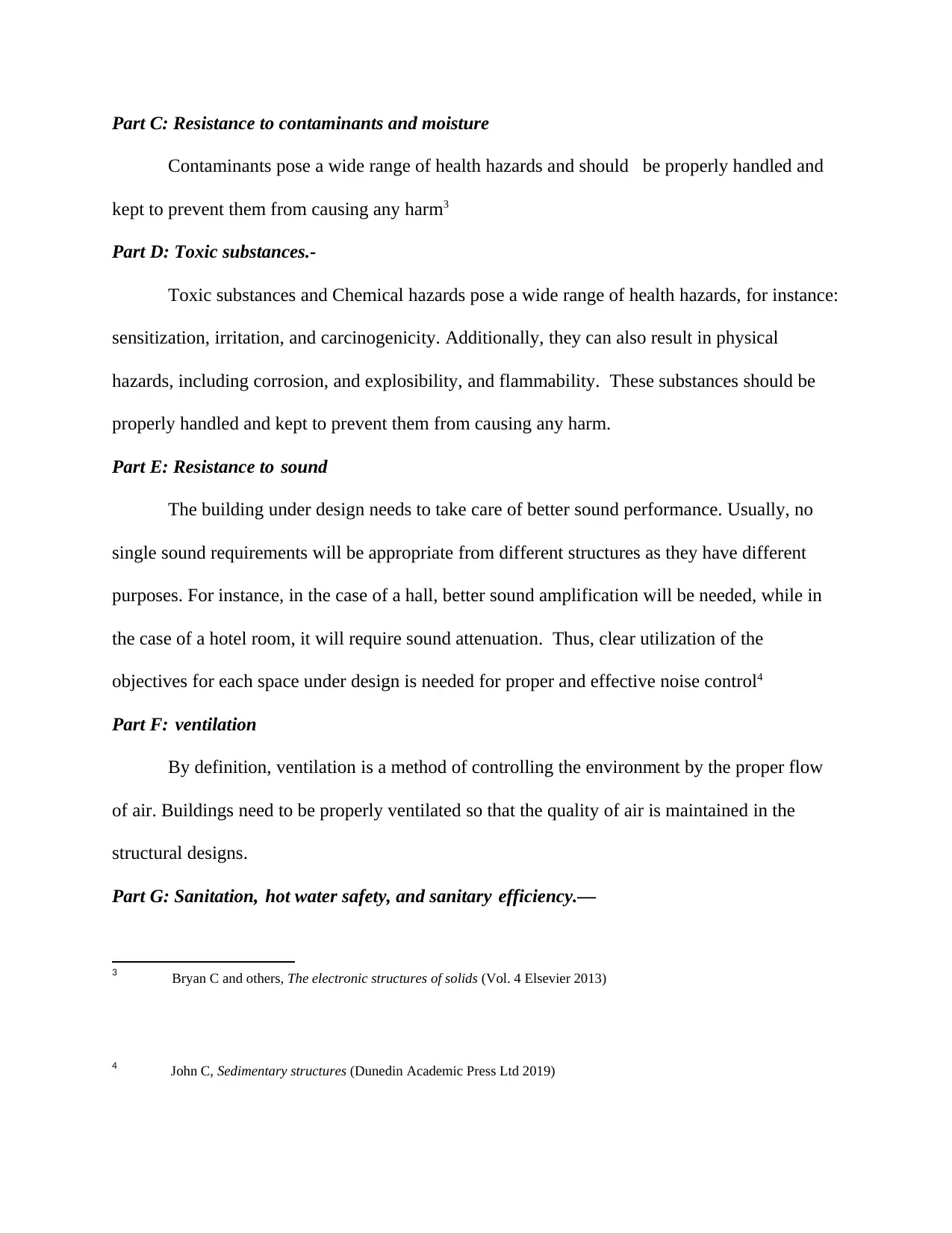
Part C: Resistance to contaminants and moisture
Contaminants pose a wide range of health hazards and should be properly handled and
kept to prevent them from causing any harm3
Part D: Toxic substances.-
Toxic substances and Chemical hazards pose a wide range of health hazards, for instance:
sensitization, irritation, and carcinogenicity. Additionally, they can also result in physical
hazards, including corrosion, and explosibility, and flammability. These substances should be
properly handled and kept to prevent them from causing any harm.
Part E: Resistance to sound
The building under design needs to take care of better sound performance. Usually, no
single sound requirements will be appropriate from different structures as they have different
purposes. For instance, in the case of a hall, better sound amplification will be needed, while in
the case of a hotel room, it will require sound attenuation. Thus, clear utilization of the
objectives for each space under design is needed for proper and effective noise control4
Part F: ventilation
By definition, ventilation is a method of controlling the environment by the proper flow
of air. Buildings need to be properly ventilated so that the quality of air is maintained in the
structural designs.
Part G: Sanitation, hot water safety, and sanitary efficiency.—
3 Bryan C and others, The electronic structures of solids (Vol. 4 Elsevier 2013)
4 John C, Sedimentary structures (Dunedin Academic Press Ltd 2019)
Contaminants pose a wide range of health hazards and should be properly handled and
kept to prevent them from causing any harm3
Part D: Toxic substances.-
Toxic substances and Chemical hazards pose a wide range of health hazards, for instance:
sensitization, irritation, and carcinogenicity. Additionally, they can also result in physical
hazards, including corrosion, and explosibility, and flammability. These substances should be
properly handled and kept to prevent them from causing any harm.
Part E: Resistance to sound
The building under design needs to take care of better sound performance. Usually, no
single sound requirements will be appropriate from different structures as they have different
purposes. For instance, in the case of a hall, better sound amplification will be needed, while in
the case of a hotel room, it will require sound attenuation. Thus, clear utilization of the
objectives for each space under design is needed for proper and effective noise control4
Part F: ventilation
By definition, ventilation is a method of controlling the environment by the proper flow
of air. Buildings need to be properly ventilated so that the quality of air is maintained in the
structural designs.
Part G: Sanitation, hot water safety, and sanitary efficiency.—
3 Bryan C and others, The electronic structures of solids (Vol. 4 Elsevier 2013)
4 John C, Sedimentary structures (Dunedin Academic Press Ltd 2019)
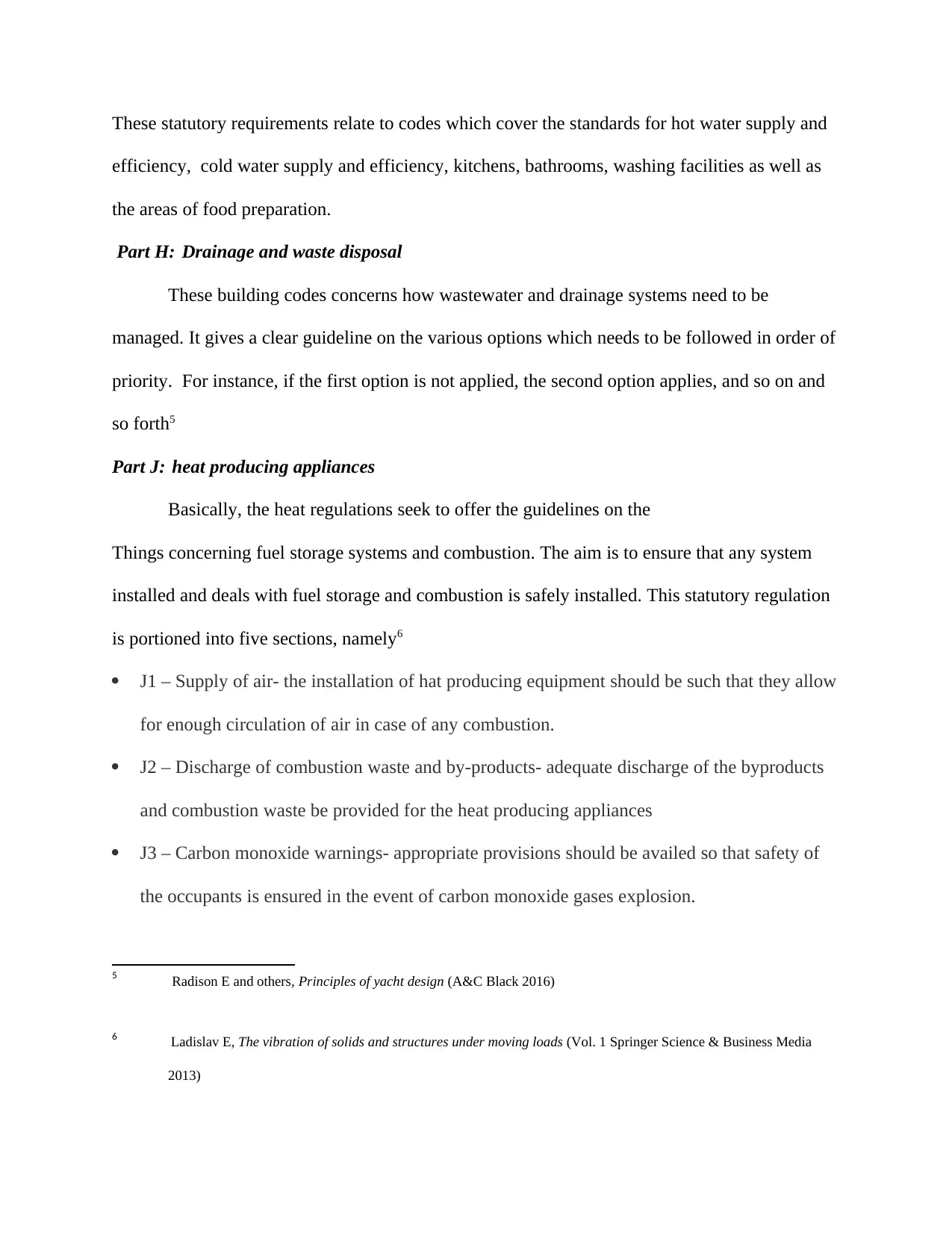
These statutory requirements relate to codes which cover the standards for hot water supply and
efficiency, cold water supply and efficiency, kitchens, bathrooms, washing facilities as well as
the areas of food preparation.
Part H: Drainage and waste disposal
These building codes concerns how wastewater and drainage systems need to be
managed. It gives a clear guideline on the various options which needs to be followed in order of
priority. For instance, if the first option is not applied, the second option applies, and so on and
so forth5
Part J: heat producing appliances
Basically, the heat regulations seek to offer the guidelines on the
Things concerning fuel storage systems and combustion. The aim is to ensure that any system
installed and deals with fuel storage and combustion is safely installed. This statutory regulation
is portioned into five sections, namely6
J1 – Supply of air- the installation of hat producing equipment should be such that they allow
for enough circulation of air in case of any combustion.
J2 – Discharge of combustion waste and by-products- adequate discharge of the byproducts
and combustion waste be provided for the heat producing appliances
J3 – Carbon monoxide warnings- appropriate provisions should be availed so that safety of
the occupants is ensured in the event of carbon monoxide gases explosion.
5 Radison E and others, Principles of yacht design (A&C Black 2016)
6 Ladislav E, The vibration of solids and structures under moving loads (Vol. 1 Springer Science & Business Media
2013)
efficiency, cold water supply and efficiency, kitchens, bathrooms, washing facilities as well as
the areas of food preparation.
Part H: Drainage and waste disposal
These building codes concerns how wastewater and drainage systems need to be
managed. It gives a clear guideline on the various options which needs to be followed in order of
priority. For instance, if the first option is not applied, the second option applies, and so on and
so forth5
Part J: heat producing appliances
Basically, the heat regulations seek to offer the guidelines on the
Things concerning fuel storage systems and combustion. The aim is to ensure that any system
installed and deals with fuel storage and combustion is safely installed. This statutory regulation
is portioned into five sections, namely6
J1 – Supply of air- the installation of hat producing equipment should be such that they allow
for enough circulation of air in case of any combustion.
J2 – Discharge of combustion waste and by-products- adequate discharge of the byproducts
and combustion waste be provided for the heat producing appliances
J3 – Carbon monoxide warnings- appropriate provisions should be availed so that safety of
the occupants is ensured in the event of carbon monoxide gases explosion.
5 Radison E and others, Principles of yacht design (A&C Black 2016)
6 Ladislav E, The vibration of solids and structures under moving loads (Vol. 1 Springer Science & Business Media
2013)
⊘ This is a preview!⊘
Do you want full access?
Subscribe today to unlock all pages.

Trusted by 1+ million students worldwide
1 out of 31
Related Documents
Your All-in-One AI-Powered Toolkit for Academic Success.
+13062052269
info@desklib.com
Available 24*7 on WhatsApp / Email
![[object Object]](/_next/static/media/star-bottom.7253800d.svg)
Unlock your academic potential
Copyright © 2020–2025 A2Z Services. All Rights Reserved. Developed and managed by ZUCOL.

